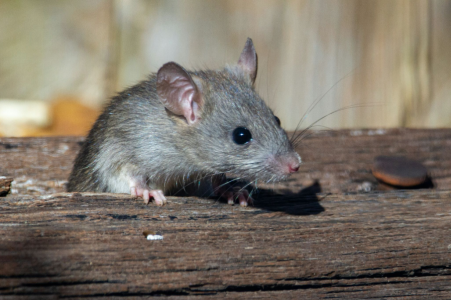Silent threat? Sneaky bird flu discovery puts USDA on high alert!
By
Aubrey Razon
- Replies 0
A startling new discovery has sparked concern among health officials. A dangerous virus is spreading in unexpected ways, raising fresh fears about its impact.
Could this latest twist signal an even bigger threat ahead?
In the tranquil suburbs of Riverside County, California, a discovery has sent ripples of concern through the U.S. Department of Agriculture (USDA) and beyond.
Four black rats, the unassuming culprits, have tested positive for the H5N1 bird flu, a virus that has been wreaking havoc on the poultry industry and now poses a new threat to public health.
This unsettling news has prompted the USDA to scramble in an effort to bolster its ranks with scientists, as the agency grapples with the implications of this latest twist in the ongoing avian flu saga.
The presence of H5N1 in black rats is not just a minor footnote in the story of this virus.
These rodents, common in urban settings, are now potential vectors for the disease, capable of transmitting it through their droppings, urine, blood, and saliva.
Their ability to move freely between farms and residential areas creates a bridge for the virus, potentially speeding up its spread to humans and their beloved pets.
This development is particularly concerning given the USDA's recent admission that it had erroneously dismissed key personnel involved in the federal response to the H5N1 outbreak.
In a statement to Newsweek, the agency acknowledged the mistake and assured the public that it is taking swift action to reverse these dismissals.
The discovery in the rats adds a new dimension to the already complex challenge of containing H5N1, which has infected over 50 mammalian species across North America.
This list includes animals as diverse as skunks, domestic cats, dolphins, seals, foxes, mountain lions, and coyotes.
The impact on US agriculture has been profound, with around 148 million poultry birds euthanized since 2022 in an effort to curb the spread.
But the virus hasn't stopped at birds.
It has also infiltrated dairy cattle, with confirmed cases in 973 herds across 17 states.
The human toll is mounting as well, with nearly 70 cases reported, primarily among those working in dairy and poultry industries, and tragically, one death in Louisiana.
The USDA's approach to managing bird flu includes surveillance, containment, and prevention.
The agency monitors commercial and backyard poultry flocks, wild birds, and dairy cattle, working with state agencies and private labs to detect outbreaks early.
When infections are identified, the USDA enforces quarantine measures and may require the culling of affected flocks.
While farmers receive compensation for losses, the economic and emotional impacts can be significant.
The USDA promotes biosecurity measures, such as restricting farm visitors and disinfecting equipment, to help reduce transmission risks.
In response to the virus's continued spread, the USDA is considering poultry vaccination, marking a shift from previous policies.
The agency collaborates with the Centers for Disease Control and Prevention (CDC) and the Food and Drug Administration (FDA) to ensure food safety and monitor potential virus mutations.
International cooperation remains important for maintaining trade stability and minimizing supply chain disruptions.
In light of the recent misstep involving the termination of avian flu support staff, a USDA spokesperson has stated, “Although several positions supporting [avian flu] were notified of their terminations over the weekend, we are working to swiftly rectify the situation and rescind those letters.”
The spokesperson emphasized the importance of these roles, noting that USDA's Food Safety and Inspection Service frontline positions are critical for public safety and ensuring a safe and adequate food supply.
The USDA is actively rehiring the bird flu scientists who were recently let go due to cost-cutting recommendations from the Department of Government Efficiency (DOGE).
The agency has made exceptions for veterinarians and emergency response personnel, recognizing the vital role they play in monitoring and controlling the bird flu outbreak.
 Have you been following the bird flu outbreak? Are you concerned about how it might affect your food supply or health? Share your thoughts with us in the comments below.
Have you been following the bird flu outbreak? Are you concerned about how it might affect your food supply or health? Share your thoughts with us in the comments below.
Could this latest twist signal an even bigger threat ahead?
In the tranquil suburbs of Riverside County, California, a discovery has sent ripples of concern through the U.S. Department of Agriculture (USDA) and beyond.
Four black rats, the unassuming culprits, have tested positive for the H5N1 bird flu, a virus that has been wreaking havoc on the poultry industry and now poses a new threat to public health.
This unsettling news has prompted the USDA to scramble in an effort to bolster its ranks with scientists, as the agency grapples with the implications of this latest twist in the ongoing avian flu saga.
The presence of H5N1 in black rats is not just a minor footnote in the story of this virus.
These rodents, common in urban settings, are now potential vectors for the disease, capable of transmitting it through their droppings, urine, blood, and saliva.
Their ability to move freely between farms and residential areas creates a bridge for the virus, potentially speeding up its spread to humans and their beloved pets.
This development is particularly concerning given the USDA's recent admission that it had erroneously dismissed key personnel involved in the federal response to the H5N1 outbreak.
In a statement to Newsweek, the agency acknowledged the mistake and assured the public that it is taking swift action to reverse these dismissals.
The discovery in the rats adds a new dimension to the already complex challenge of containing H5N1, which has infected over 50 mammalian species across North America.
This list includes animals as diverse as skunks, domestic cats, dolphins, seals, foxes, mountain lions, and coyotes.
The impact on US agriculture has been profound, with around 148 million poultry birds euthanized since 2022 in an effort to curb the spread.
But the virus hasn't stopped at birds.
It has also infiltrated dairy cattle, with confirmed cases in 973 herds across 17 states.
The human toll is mounting as well, with nearly 70 cases reported, primarily among those working in dairy and poultry industries, and tragically, one death in Louisiana.
The USDA's approach to managing bird flu includes surveillance, containment, and prevention.
The agency monitors commercial and backyard poultry flocks, wild birds, and dairy cattle, working with state agencies and private labs to detect outbreaks early.
When infections are identified, the USDA enforces quarantine measures and may require the culling of affected flocks.
While farmers receive compensation for losses, the economic and emotional impacts can be significant.
The USDA promotes biosecurity measures, such as restricting farm visitors and disinfecting equipment, to help reduce transmission risks.
In response to the virus's continued spread, the USDA is considering poultry vaccination, marking a shift from previous policies.
The agency collaborates with the Centers for Disease Control and Prevention (CDC) and the Food and Drug Administration (FDA) to ensure food safety and monitor potential virus mutations.
International cooperation remains important for maintaining trade stability and minimizing supply chain disruptions.
In light of the recent misstep involving the termination of avian flu support staff, a USDA spokesperson has stated, “Although several positions supporting [avian flu] were notified of their terminations over the weekend, we are working to swiftly rectify the situation and rescind those letters.”
The spokesperson emphasized the importance of these roles, noting that USDA's Food Safety and Inspection Service frontline positions are critical for public safety and ensuring a safe and adequate food supply.
The USDA is actively rehiring the bird flu scientists who were recently let go due to cost-cutting recommendations from the Department of Government Efficiency (DOGE).
The agency has made exceptions for veterinarians and emergency response personnel, recognizing the vital role they play in monitoring and controlling the bird flu outbreak.
Key Takeaways
- The U.S. Department of Agriculture confirmed H5N1 bird flu in four black rats in Riverside County, California, representing a new risk for transmission pathways that include droppings, urine, blood, and saliva.
- The bird flu outbreak has significantly impacted US agriculture, with approximately 148 million poultry birds euthanised since 2022 and cases now confirmed in dairy cattle across 17 states.
- The USDA is implementing surveillance, containment and prevention measures to combat bird flu, including strict quarantine and culling procedures for infected flocks, and is testing new vaccines amidst the ongoing spread.
- The USDA aims to rehire bird flu scientists recently terminated due to cost-cutting measures, with the agency exempting veterinarians and emergency response personnel from these cuts to ensure continued focus on bird flu monitoring and control efforts.







